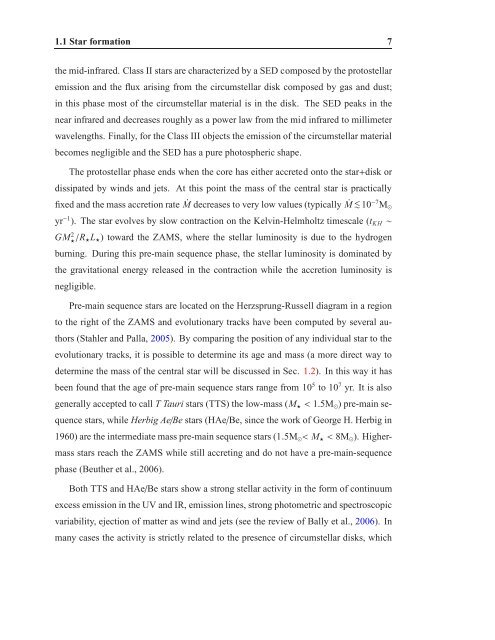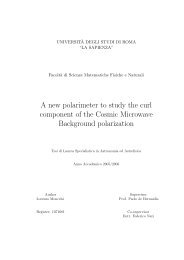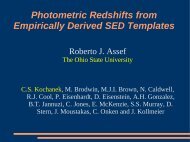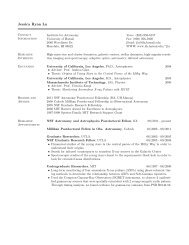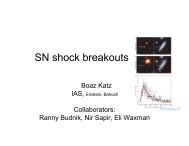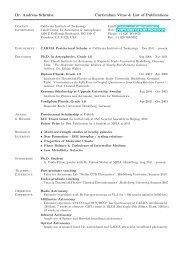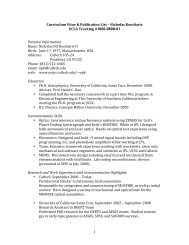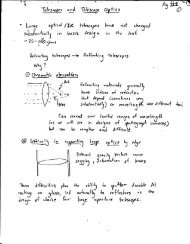Interferometric observations of pre-main sequence disks - Caltech ...
Interferometric observations of pre-main sequence disks - Caltech ...
Interferometric observations of pre-main sequence disks - Caltech ...
Create successful ePaper yourself
Turn your PDF publications into a flip-book with our unique Google optimized e-Paper software.
1.1 Star formation 7<br />
the mid-infrared. Class II stars are characterized by a SED composed by the protostellar<br />
emission and the flux arising from the circumstellar disk composed by gas and dust;<br />
in this phase most <strong>of</strong> the circumstellar material is in the disk. The SED peaks in the<br />
near infrared and decreases roughly as a power law from the mid infrared to millimeter<br />
wavelengths. Finally, for the Class III objects the emission <strong>of</strong> the circumstellar material<br />
becomes negligible and the SED has a pure photospheric shape.<br />
The protostellar phase ends when the core has either accreted onto the star+disk or<br />
dissipated by winds and jets. At this point the mass <strong>of</strong> the central star is practically<br />
fixed and the mass accretion rate ˙M decreases to very low values (typically ˙M< ∼ 10 −7 M⊙<br />
yr −1 ). The star evolves by slow contraction on the Kelvin-Helmholtz timescale (tKH∼<br />
GM 2 ⋆ /R⋆L⋆) toward the ZAMS, where the stellar luminosity is due to the hydrogen<br />
burning. During this <strong>pre</strong>-<strong>main</strong> <strong>sequence</strong> phase, the stellar luminosity is dominated by<br />
the gravitational energy released in the contraction while the accretion luminosity is<br />
negligible.<br />
Pre-<strong>main</strong> <strong>sequence</strong> stars are located on the Herzsprung-Russell diagram in a region<br />
to the right <strong>of</strong> the ZAMS and evolutionary tracks have been computed by several au-<br />
thors (Stahler and Palla, 2005). By comparing the position <strong>of</strong> any individual star to the<br />
evolutionary tracks, it is possible to determine its age and mass (a more direct way to<br />
determine the mass <strong>of</strong> the central star will be discussed in Sec. 1.2). In this way it has<br />
been found that the age <strong>of</strong> <strong>pre</strong>-<strong>main</strong> <strong>sequence</strong> stars range from 10 5 to 10 7 yr. It is also<br />
generally accepted to call T Tauri stars (TTS) the low-mass (M⋆< 1.5M⊙) <strong>pre</strong>-<strong>main</strong> se-<br />
quence stars, while Herbig Ae/Be stars (HAe/Be, since the work <strong>of</strong> George H. Herbig in<br />
1960) are the intermediate mass <strong>pre</strong>-<strong>main</strong> <strong>sequence</strong> stars (1.5M⊙< M⋆< 8M⊙). Higher-<br />
mass stars reach the ZAMS while still accreting and do not have a <strong>pre</strong>-<strong>main</strong>-<strong>sequence</strong><br />
phase (Beuther et al., 2006).<br />
Both TTS and HAe/Be stars show a strong stellar activity in the form <strong>of</strong> continuum<br />
excess emission in the UV and IR, emission lines, strong photometric and spectroscopic<br />
variability, ejection <strong>of</strong> matter as wind and jets (see the review <strong>of</strong> Bally et al., 2006). In<br />
many cases the activity is strictly related to the <strong>pre</strong>sence <strong>of</strong> circumstellar <strong>disks</strong>, which


